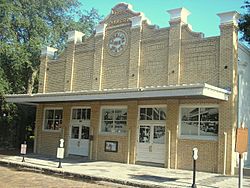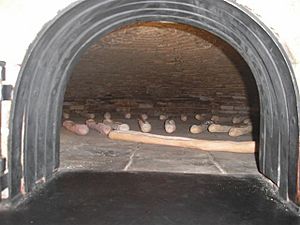Cuban bread facts for kids

Cuban bread is used to make Cuban sandwiches.
|
|
| Type | White bread |
|---|---|
| Place of origin | United States |
| Region or state | Florida |
| Created by | La Joven Francesca Bakery |
| Main ingredients | Flour, water, lard or vegetable shortening |
Cuban bread is a special type of white bread. It is similar to French bread or Italian bread. However, it has a slightly different recipe and baking method. It usually includes a small amount of fat, like lard or vegetable shortening. This bread is often made in long, thin loaves, much like a baguette. It is a very important food in Cuban-American cooking. It is the traditional bread used to make an authentic Cuban sandwich.
The History of Cuban Bread

People often debate where "real" Cuban bread first came from. Both Miami and Tampa, Florida, claim to make the best Cuban bread.
The first bakery in the U.S. to sell Cuban bread was likely La Joven Francesca. This bakery was started by Francisco Ferlita in 1896. Francisco was born in Sicily. His bakery was in Ybor City, Tampa. Ybor City was a busy community with Cuban, Spanish, and Italian people.
At first, the bakery sold bread for only 3 to 5 cents a loaf. Many loaves were delivered every morning, just like milk. Houses in Ybor City often had a strong nail on the front porch. A bread delivery person would place a fresh loaf of bread onto this nail before dawn.
A fire destroyed Ferlita's bakery in 1922. Only the brick bread oven was left standing. But the bakery was rebuilt and made even bigger. It soon became a main supplier of Cuban bread for the Tampa area. The bakery also added a dining area. This became a popular spot for people to meet, drink Cuban coffee, and hear the local news.
La Joven Francesca closed in 1973. But it found new life when it was fixed up and became the Ybor City State Museum. You can still see the original ovens where the first Cuban bread was baked!
Today, La Segunda Bakery in Ybor City makes the most Cuban bread in the world. They ship their bread all over Florida and beyond. Juan Morè helped start La Segunda. He moved to Tampa from Spain, after living in Cuba. He became a partner in a group of bakeries. Morè bought the larger La Segunda building in 1915. His family has been running the bakery ever since. They still use Morè's original Cuban bread recipe and many of the same old baking methods.
What Makes Cuban Bread Special?
A traditional loaf of Cuban bread is about three feet long. It is somewhat rectangular in shape. It has a hard, thin, and almost papery crust. The inside is soft and flaky.
In the past, bakers stretched the dough very thin. This made the bread last longer. It also created the bread's unique air pockets and long shape. For over a century, bakeries like La Segunda still use a special method. They lay a long, moist palmetto frond on top of the loaves before baking. This creates a shallow line in the top crust. It's similar to how European breads are scored or cut. The frond is removed before you eat the bread.
Cuban bread is the most important part of a "Cuban sandwich". This sandwich is sometimes called a "sandwich mixto." You can also enjoy Cuban bread for breakfast. It's often toasted and pressed with butter. People like to eat it with a hot mug of cafe con leche. This is strong, dark-roasted Cuban coffee with scalded milk. Many people like to dip their bread into the coffee!
Traditional Cuban bread does not use preservatives. This means it can go stale quickly. It becomes hard and dry if it's not eaten soon after baking. However, you can freeze it for shipping or storage. In Tampa, stale Cuban bread became a key ingredient in other recipes. For example, it's used to make the breading for a deviled crab.
Other Fun Uses
Stale Cuban bread is sometimes used in playful protests. The Conch Republic uses it in their demonstrations. It's also used in mock battles by the "Ybor City Navy" during Tampa's Gasparilla Pirate Festival.
See also
 In Spanish: Pan cubano para niños
In Spanish: Pan cubano para niños


